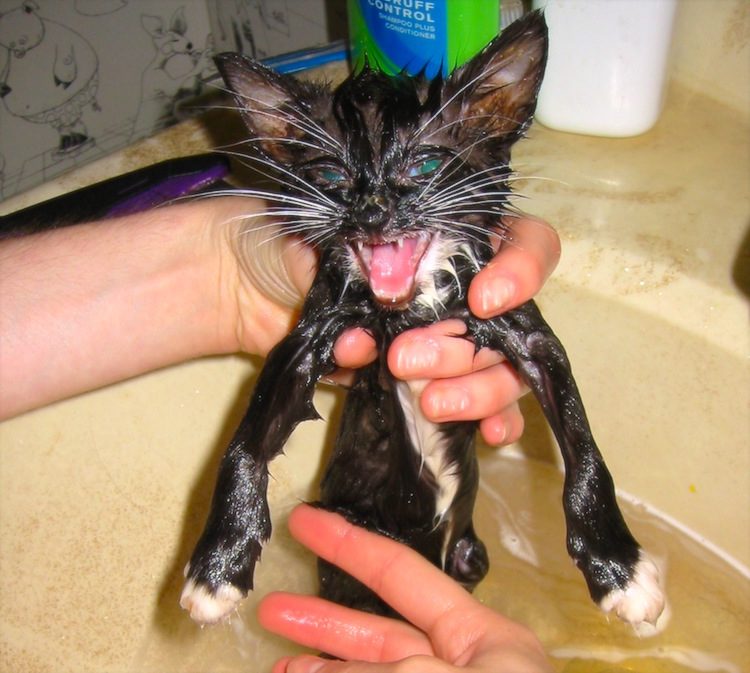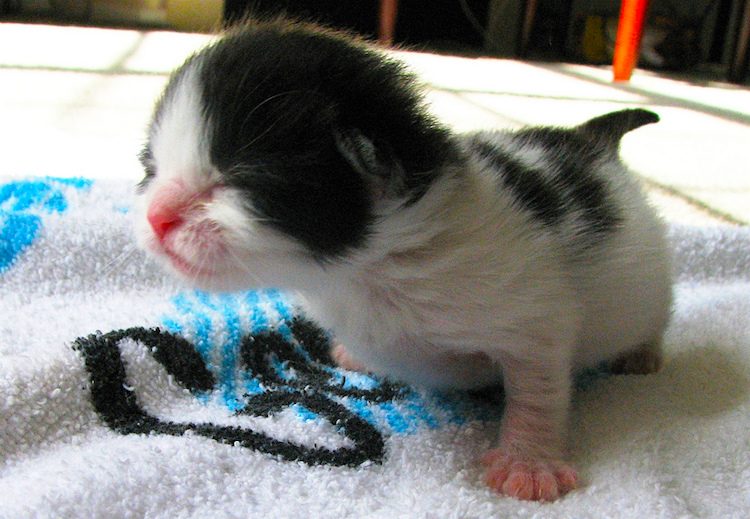How To Get Rid Of Fleas On Kittens

There aren't many things cuter than a kitten, but imagine your shock when playing with your new pet and finding fleas.
These little bloodsucking flightless insects can cause major problems for kittens and need to be removed.
Fleas can find their way to a kitten in many ways, even if the kitten is strictly an indoor-only cat. For example, the mom cat may have fleas, other pets may have brought in fleas, and sand tracked indoors can even contain fleas.
As soon as you notice there are fleas either in the house or on a pet, take action.
The Worst Thing You Can Do: Nothing
A flea infestation can cause anemia in kittens.
"A flea doesn't actually bite," explains Dr. William Miller Jr., VMD. "It sticks its proboscis into the skin and sucks blood. It doesn't take too much of this sucking to cause anemia in a kitten that is carrying innumerable fleas. You don't see this problem very often in adult cats, but it's frequently seen in kittens."
- Make sure your kittens gums are pink since this condition can be deadly, and bring your kitten to the veterinarian if you notice a discoloration.
- Fleas on kittens (and on any other animal) can also cause excessive scratching and skin irritation.
Kittens are especially delicate, and some flea treatments are not safe. Follow the advice of your vet. Also, never use medication designed for dogs or adult cats — these could be deadly to a kitten.
If you are removing fleas from a newborn kitten: Treat the mother. Then remove the fleas from the kitten. A kitten's body is small so there isn't a large area to cover, and you should be able to remove the fleas with your fingers or tweezers easily. Because of newborn kittens' young age and fragility, do not apply any type of detergent or medication on them.

How to Safely Remove Fleas From Kittens
1. Dampen the kitten's coat.
First, dampen the kitten's coat with warm (not hot) water.
"Exercise caution when bathing the kitten, as baths can be traumatic to a kitten if done incorrectly," says Hannah Shaw, who has fostered many young kittens.
"Try to complete the entire bath in less than 2 minutes, as kittens can become panicked or chilled during this process," she advises.
Fleas will move to the driest area of the kitten, so it is not unusual to see them swarm to the head and facial area. If you can grab these fleas with your fingers or tweezers, drop them into a cup of hot, soapy water.
2. Comb out the fleas while the fur is damp.
While the kitten's fur is still damp, go over the kitten with a simple flea comb.
Again drop any fleas into the cup of hot, soapy water as you find them.
Repeat this sequence — dampening the kitten's fur and using the flea comb — daily as needed.
Dusty Rainbolt, in Kittens for Dummies, says with any new kitten, "I immediately grab my flea comb and look for flea dirt. That icky black stuff … is actually flea poop."
She explains that the best kind of flea comb for young kittens is one with extra fine teeth. "Don't waste your money on the plastic ones because the fleas just pass right through the teeth," Rainbolt says.
3. Towel dry the kitten.
Dry the kitten right away — and completely.
"Place the kitten back into a warm environment, such as a heating disk or baby blanket," says Shaw. "Kittens can easily become chilled from a bath, and it is of utmost importance that the kitten be kept warm."
4. Clean the bedding or blankets.
Place the dry kitten in an area free from fleas and grab a plastic bag or trash bag. Gather up all bedding and fabric the kitten may have come in contact with and wash them in hot water.
Vacuum any areas the kitten has come in contact with, and treat any other kittens (or the mother, if present and also carrying fleas).
It's important to clean the environment as well as the animals — otherwise, the fleas will be a persistent problem.
"Treatment of the whole house is essential, including soft furnishings, carpet pile, gaps between floorboards and other difficult-to-reach areas," according to International Cat Care.
What About Flea Medicine for Kittens?
There are flea medications readily available to treat the mother or adult cat.
Medications for kittens are determined by age and can be deadly, so it's important to check with your vet before applying anything.
A few more pointers:
- Again, newborn kittens need manual flea removal.
- In consultation with your vet, kittens over 4 weeks old may be treated with Capstar (there is a minimum weight requirement). This application kills the adult fleas but not their offspring.
- Other flea medications safe for kittens list 8 weeks of age as a minimum.
- Natural, homeopathic or essential oil treatments may harm your kitten, so avoid using these, especially if you haven't consulted your vet first.
Here's a video explaining more about treating a kitten for fleas:
Fleas are pesky, tiny insects, and multiple washings and cleanings may be necessary. Even after the initial treatment of your kitten and home, you may still see a few fleas here and there.
Kill or remove these remaining fleas as soon as you see them, and keep checking your kitten to make sure no more fleas return.
As your kitten gets older, you will be able to switch to topical treatments suitable for adult cats — but until then, stay vigilant and treat on the spot.
References
[accordion tag=p clicktoclose="true"]
[accordion-item title="+ Click to see the sources for this article."]
- "Fleas: A Source of Torment for Your Cat." Cornell University College of Veterinary Medicine. 2016. https://www.vet.cornell.edu/departments-centers-and-institutes/cornell-feline-health-center/health-information/feline-health-topics/fleas-source-torment-your-cat.
- Shaw, Hannah. "Fleas." 2018. http://www.kittenlady.org/fleas.
- "Safe Use of Flea and Tick Preventive Products." American Veterinary Medical Association. https://www.avma.org/public/PetCare/Pages/Safe-use-of-flea-and-tick-preventive-products.aspx.
- Rainbolt, Dusty. Kittens for Dummies. John Wiley & Sons. 2019. 292. https://books.google.com/books?id=squkDwAAQBAJ&pg=PT292#v=onepage&q&f=false.
[/accordion-item][/accordion]
 This pet health content was reviewed for accuracy by a veterinarian, Dr. Pippa Elliott, BVMS, MRCVS. This article was originally published in 2012 and is regularly updated. It was last reviewed for accuracy and updated Aug. 24, 2019.
This pet health content was reviewed for accuracy by a veterinarian, Dr. Pippa Elliott, BVMS, MRCVS. This article was originally published in 2012 and is regularly updated. It was last reviewed for accuracy and updated Aug. 24, 2019.
If you have questions or concerns, call your vet, who is best equipped to ensure the health and well-being of your pet. This article is for informational purposes only and is not a substitute for professional medical advice, diagnosis or treatment. See additional information.
How To Get Rid Of Fleas On Kittens
Source: https://www.petful.com/pet-health/flea-medicine-for-kittens/
Posted by: avileswifing.blogspot.com

0 Response to "How To Get Rid Of Fleas On Kittens"
Post a Comment